Phantom Games
Louigi Verona
July 2021
Overview
Simply speaking, phantom games is a class of games the goal of which is to figure out their rules. They are not just puzzles, because the idea is that phantom games should continue to be fun to play even after you have discovered how they work.
Although this could be a really fun challenge for the players, in reality phantom games are more of a game design exercise. In my experience, designing a phantom game allows you to explore mechanics that you would otherwise never think of. What starts out as a phantom game might eventually become a "normal" game or puzzle. In other words, phantom games offer a very unusual approach to game design that forces you to be creative.
And even in cases when it's not leading to a game, it's an intellectually engaging recreational activity. Just coming up with a phantom game idea and thinking its design through could be a really fulfilling creative project.
In this article we will understand what designing a phantom game entails and then go through actually designing one from scratch.
Origins of the idea
Imagine you watch two people play a game, the rules of which you don't know. Everything they do seems complicated and mysterious. But when they explain the rules, it turns out the game is deviously simple.
I have always been fascinated by processes that appear to be very complicated, but would actually be governed by uncomplicated rules. It started with party gags.
One of the more known ones is about elephants in a bottle. It involves asking everyone "How many elephants are in a bottle?" It's also great if at least someone in the crowd knows the secret, so that they can deliver correct answers. The way the gag plays out is that one by one people end up figuring it out, invariably leaving a couple of folks who still can't get it, to the amusement of everyone.
The solution to this particular gag is that one has to count the amount of words in the question - and that's the amount of elephants. So, if one were to ask "How many elephants are in a bottle?", the correct answer would be 7. If the question is posed as "So, how many elephants?", the answer would be 4.
And the beauty of the puzzle is in the contrast: how confusing and complicated it seems at first, and how simple it turns out to be. One might even suggest that that's exactly what makes a great puzzle - it should appear impossible, but have an elegant and simple solution.
Another aspect that fueled my inspiration was seeing fictional games being played in movies. In one of the episodes of Star Trek: The Next Generation we are shown an electronic game called "Strategema". The rules of the game are never explained (and I strongly suspect they were never designed), so all you can do is watch the game's interface and wonder what its rules are.
And so I realized that it would be fun to create a game which would be based on an extremely simple principle, but at the same time force players to do all sorts of things, creating an elaborate illusion of complexity for the outside observer.
That in itself is a challenge, as we will soon see. However, when devising the concept, I wanted to go a step further. After all, the problem with the aforementioned party gag is that once everyone knows the secret, playing it is no longer interesting. So, I set out to devise a type of game which would appear completely incomprehensible to the outside observer, have a simple and elegant explanation, and yet be interesting enough to be played even when you know its rules.
I call this class of games "phantom games".
They are as fun as they are challenging to design. Let's think what requirements a phantom game should satify.
Phantom game requirements
First, it must be based on a simple principle. Simplicity and elegance are not easy to define. But, for example, we could define simplicity in terms of mental effort: the principle should not require much effort to be applied. In the example of our "elephants in a bottle" gag, counting the amount of words in a question does exert some mental effort, but not overly so. In fact, we do want some effort, since the illusion of complexity becomes more complete if players are forced to think just enough that they appear to be considering something before making a move. But while the outside observers imagine complex calculations and strategy, all you're really doing is counting words in a question.
That alone is a serious intellectual challenge. Coming up with a compelling setup that would look complex, but be simple is not at all easy.
Second, the system should have the right level of immunity to random input: you want to make sure that random successes are highly unlikely. Perhaps you might want people to sometimes randomly get it right, so that the process doesn't become too demoralizing, but this balance should be kept in check. There is a lot of space for fun here, since a rule might have an obvious, but incorrect hypothesis, and the game master might introduce a situation where the obvious hypothesis suddenly fails.
Third, it should be possible to prove that there are, in fact, rules, but do it in a way that doesn't give the rules themselves away. In party gags this would be typically achieved through the help of folks who know the gag and are able to consistently provide the right answers. This way they are making it clear to the new players that there is a system, and yet that system is not directly revealed.
This situation is very similar to what is known as "zero-knowledge proof", when person A needs to convey to person B that they know the value of x without revealing the value of x. In our case I am not proposing a zero-knowledge proof, but rather what I call a "cryptic proof": a proof that does give away the rules, but in a very obfuscated manner. Another way to describe cryptic proof is that an expert player should be able to solve the puzzle in front of the beginner and give away very little.
The "elephants in a bottle" gag relies on cryptic proof, as each new round both proves that there is a rule, but also leaks information about it. Eventually, other players catch on.
Interestingly enough, "cryptic proof" is applicable to many puzzles. For instance, if you don't know how to solve a Rubik's cube and are not sure that it's even solvable, I could solve it in front of you. If I do it expertly and quickly, the complexity of the solution is unlikely to give away much, if anything, to the beginner. But if I do it again and again, each time starting from random permutations of the cube, eventually the beginner will be able to learn.
In our case, of course, the challenge is that we want the underlying principle to be as simple as possible, while retaining the appearance of complexity. And we cannot simply rely on the expert player creating the illusion of complexity on purpose: we should instead design the game in a way that would force even the most lazy expert to solve the puzzle without making the principle obvious.
This is actually one of the most fun parts of the design. You'd be surprised how quickly your rules become complicated. And finding the simplest way to obfuscate how the game works is very satisfying.
Fourth, it should be possible to figure out the answer, at least theoretically. If someone is eventually just told the rules, they should feel that hints to the solution were there all along.
But those requirements still describe what might be no more than a gag, even if a good one. The important addition here is the fifth requirement: once you know the rules, it should still be fun to play. There should be a level 2. And yet - this level 2 should not compromise level 1: the fact that there is a level 2 should not compromise level 1 gameplay whatsoever.
A simple way to do it is to say that you get additional points if you solve the puzzle quickly or in any other way optimizing your performance. But there are, of course, many other ways that a level 2 could be unlocked.
At this point all of this might seem very theoretical. So, let's just go ahead and design a phantom game.
Designing a phantom game from scratch
Let's begin with some basic premise. Let's say, we have a light and we need to switch it on. Normally, you would have a light switch. But this should be a puzzle, so we'll have several switches.
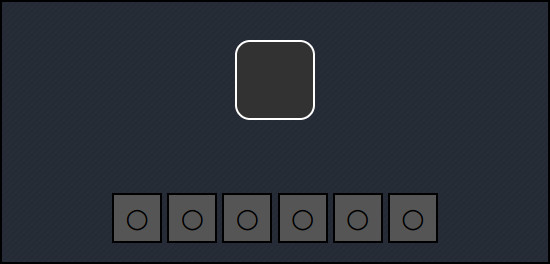
This is our starting point: we want the player to enter a combination and have the light switch on.
Now we need to come up with a principle. Since we want to ensure that the principle is simple, let us take the simplest one possible: a player can click any key - and the light will switch on. Obviously, this is way too simple, so let's begin complicating it and instead postulalte that one needs to click, say, any three switches.
The problem with this is that if a beginner would be observing an expert, the expert could simply click the first switch three times in a row. And we don't want to rely on expert players being sneaky on purpose: we need the game to force them to be sneaky. Which in this case means that we want to force the players to press three different keys.
Well, we can have each switch be clickable just once: when you click on it, it stays pressed. This is not enough, though, since the simplest thing to do would be to just click on the first three switches each time. We need something else, something to force the player to break up their pattern.
We can introduce colors. We have three colors and the principle is this: you need to click on one of each. We will also randomize the order at the beginning of each round.
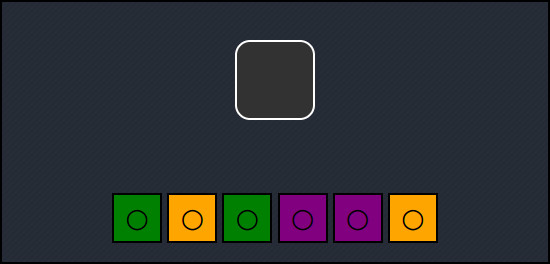
In the example on the picture you would need to click switches 1, 2 and 4. In fact, if you do want to get extra sneaky, you have room for a lot of variation. For instance, you can choose to do 6, 5, 3. But if you click 1, 2, 3 - this will be an error. In this case we'll reset all the switches and you would need to start again.
This effectively breaks up the pattern and forces the player to go for a new combination each time, all the while keeping things simple. This also ensures that random inputs won't be successful frequently. In fact, when we finish designing our puzzle and you'll get the chance to try it out, you'd be suprised as to how well it works: the balance between random successes and failures is exactly the ratio I typically strive for.
Alright, so we found a mechanic which seems to work reasonably well. But a beginner will probably figure it out very quickly. How can we obfuscate it?
Let's move the colors off the switches. We can add the name of the puzzle on top and color each separate letter. That means that the name of the puzzle should consist of the same amount of letters as the amount of switches. That way, the principle is not going to be immediately obvious, while the changing colors of the title would hint towards the solution.
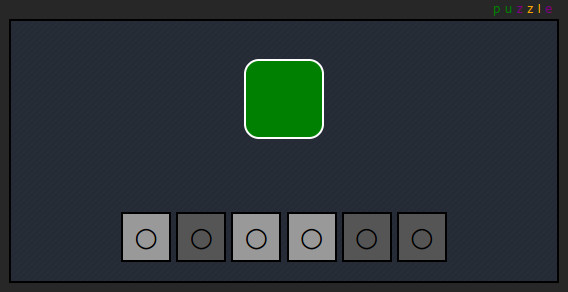
Let's summarize what we've got so far. We have the title of the puzzle in the upper part, which provides the color code for the switches. Each switch is clickable only once and you would need to click three of them, by clicking those that correspond to each of the three colors.
Note, that the rule satisfies many of our requirements: it satisfies our simplicity test, as there's almost no effort required to come up with the right combination; it's immune to random input, allowing only for occasional successes; it allows for cryptic proof - the expert player would be able to solve the puzzle again and again, while giving away nothing but a series of seemingly random switch combinations; and the hints are all there - you have the changing colors in the title which are right in front of you.
We can continue enhancing our puzzle. For instance, in order to formalize our cryptic proof, we can introduce a series of attempts. One can claim that they beat the puzzle if they get it right 5 times in a row. We can place a very basic progress bar on top of the light, and each time you get the light to switch on, it increases the counter. And if you make a mistake, the counter resets. Therefore, it forces you to only win if you truly understand the rule, and at the same time allows the expert player to prove that they can beat the game every time.
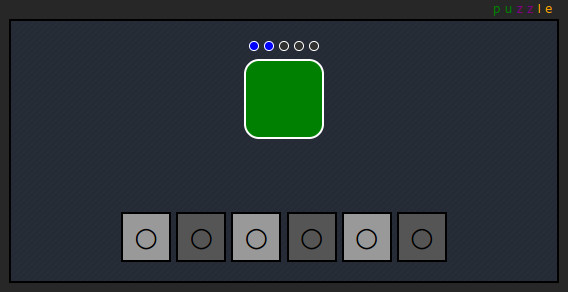
So, we've satisfied four requirements. What about the fifth one? How can we add an additional layer to the puzzle - and yet, do it in a way that won't mess up the already existing setup?
This is probably the most difficult part, but could also be the most rewarding. One idea is to use the 5 small lights, our newly added counter. Level 2 might be this: when the counter increments, you get an additional bonus if you end your combination on the switch in the same position:

In the situation on the picture above, the counter is at number 2. Therefore, you get an additional bonus if you end your 3-switch combination at the switch in the second position. And when the counter is at 0 in the beginning, you can end your combination anywhere.
The reward could be that if you manage to do this right every time, the background of the puzzle will change to something festive.
Notice that this additional layer leaves previous gameplay completely intact. You can still win normally if you don't know this rule. You would be very unlikely to achieve it randomly. It adds much more mental overhead and might make the puzzle a lot more satisfying and even replayable. And it also makes it way more confusing for the outside observer, since now your combinations are going to be all over the place and you might also be taking longer time to think: the basic idea of the puzzle is very simple, but you would be playing at the next level by this point!
But it's still a puzzle, albeit with several layers. How do we turn it into a game?
We add a timer that will post the amount of time spent on all 5 attempts - and the puzzle turns into an actual game of skill! Now, even though you know the rules, it makes sense to continue playing - at least, in principle.
Some finishing touches should include some sort of hints functionality. If you were to demonstrate the puzzle to your friends, you would be able to show them how you can expertly beat the puzzle. But in an online situation you want to prove that the puzzle is beatable through introducing an automatic hints system. As you try it out, notice that the hints system, by virtue of choosing the right combination randomly, gives away very little. There doesn't seem to be much of a system.
Here's how the final version looks like, which you can play here:
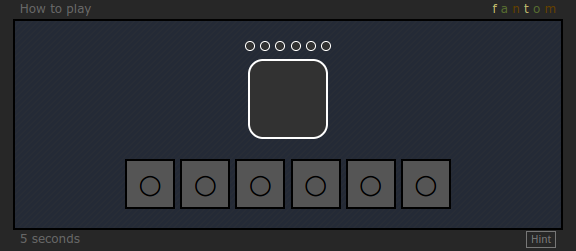
Notice, that I went with more muted colors so that them changing around all the time is less obvious.
There are many other ways to improve the puzzle. Like, adding additional elements, which would create an illusion that they are relevant to the solution and that the puzzle is more difficult than it really is. Allow the players to find a system in some random elements. In fact, when you see people in the process of solving these kinds of puzzles, they trick themselves into all sorts of rules, and sometimes stick to them even when the puzzle proves that the idea is wrong: we all get locked into certain ideas when problem solving.
And then these additional elements can provide ample space for your level 2.
Examples of other phantom games
Please note that our quick example is not the limit of what phantom games can do. Quite the contrary. I would even go as far as to say that our "light and switches" idea is pretty unimaginative. It does work swimmingly as an example, because it allows me to walk you through the reasoning without being distracted by the particulars of the game.
Not that a puzzle like that can not be jazzed up a little. My very first attempt at a phantom game some years ago is basically a glorified version of the same thing we've just designed. It uses a slightly different principle, but employs a lot of similar mechanics. It's called "Phantom 100" and is a desktop game that can be downloaded here.
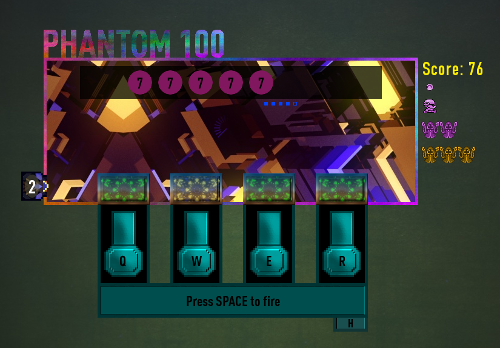
If you just want to check out its gameplay, here is a YouTube video. It's a slightly earlier version of the app and lacks a couple of features, but otherwise the gameplay is identical.
I also developed a variation on our basic "fantom" game which I called "the borpyg puzzle". It doesn't have the game part or level 2 and is really just a puzzle:

Phantom game ideas
There are really no limits to what a phantom game might look like. It could look like a fighting game, where you need to figure out how to consistently beat your oppoenent. Or a strategy game. Or tower defense. Literally, anything.
Some concrete examples I thought of (and some of which I might one day implement):
- Shooting a target with an arrow. The player has many parameters that they need to adjust before shooting the arrow, but the secret is deviously simple. I am envisioning a sort of a mechanical machine where you seem to need to manipulate various levers and rotate wheels to change how the arrow is fired. If you don't know the secret, your arrows will tend to perform near-hits, no matter how accurately you think you tweaking the machine. Level 2 might be hitting additional tagets. Say, sometimes your arrows go off screen when you miss. Well, you can perform special shots which fire the arrow up beyond the screen - and hit various birds that then fall down.
- A game similar to battleship. You target your opponent's fleet, but most of what you do is for show - the real way to win might be something like which weapon to use based on a change in the logo or something.
- A slot machine with a secret. I would not make the secret principle to just let you win everytime, but instead experiment with near-losses, when, in spite of all the odds, if you know the principle - you somehow keep surviving. A beginner player would just play the slot as if it were a normal slot and quickly lose.
- A vague idea around how the "move" is the same, but it translates into exciting and unpredictable game progress. Whereas if you don't know the move, you win normal bonuses, but truly progressing is hard to impossible. This could create an illusion that one requires amazing skill to be good at the game, whereas that's actually not the case. I also just like the idea how you can get really complex and impressive results by doing something simple. The idea came from playing bad console games, where you don't know what you're doing and end up just mashing buttons, but occasionally get something spectacular to happen, like suddenly getting all monsters on screen destroyed. And I thought - what if you were to know what to do in order to consistently get great results in the game, but not really control what those results would be. So, a blend of the phantom game principle and a zero-player game.
- A "one step forward" idea: the game tells you what happens next, but you need to know where to look. This way you can bullshit your way through complicated strategy (which, in reality, is non-existent, of course), and confuse the observers. For instance, imagine some sort of turn-based wargame. You know how to see what happens next. Say, the game tells you how to win and also a way to lose. And let's say that the outcome of your move will be that several of enemy's tanks are going to be successfully mined and exploded. You can then talk about how what you do is going to accomplish that, although in reality none of the actions you do are connected to reality.
A lot of them sound like practical jokes. But it is the process of thinking through these that begins to fuel your imagination. How would you implement them? How can I make it both confusing and elegant? And out of playing with these naughty designs new games might emerge.
How a phantom game exercise helped me invent a game
Interestingly enough, I already have an example of a game that came out of fiddling around with a phantom game concept: Arithmetical Tennis.
Arithmetical Tennis is a really fun idea to begin with - a game with no equipment - but now that you have seen how a phantom game could be designed, notice that there are elements in Arithmetical Tennis that are betraying its design origins: it was initially a straight out phantom game. The whole bit with the numbers was initially made to be confusing, so that external observers would have no idea what's going on and would need to guess what the next digit should be. And the mechanic of requiring to return 1, 2, 3 or 4 digits back came out of me trying to randomize the response, so that it feels more complicated than it is. I didn't want to rely on players being sneaky, so I forced them to be sneaky. But that, in turn, gave me a very interesting mechanic that I was then able to turn into a real game.